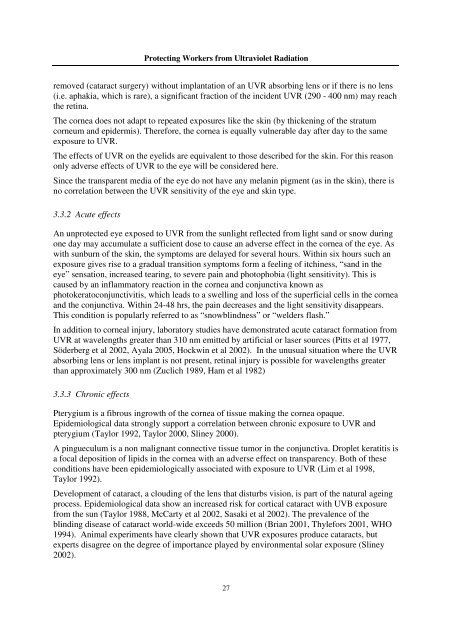Protecting Workers from Ultraviolet Radiation - icnirp
Protecting Workers from Ultraviolet Radiation - icnirp
Protecting Workers from Ultraviolet Radiation - icnirp
Create successful ePaper yourself
Turn your PDF publications into a flip-book with our unique Google optimized e-Paper software.
<strong>Protecting</strong> <strong>Workers</strong> <strong>from</strong> <strong>Ultraviolet</strong> <strong>Radiation</strong><br />
removed (cataract surgery) without implantation of an UVR absorbing lens or if there is no lens<br />
(i.e. aphakia, which is rare), a significant fraction of the incident UVR (290 - 400 nm) may reach<br />
the retina.<br />
The cornea does not adapt to repeated exposures like the skin (by thickening of the stratum<br />
corneum and epidermis). Therefore, the cornea is equally vulnerable day after day to the same<br />
exposure to UVR.<br />
The effects of UVR on the eyelids are equivalent to those described for the skin. For this reason<br />
only adverse effects of UVR to the eye will be considered here.<br />
Since the transparent media of the eye do not have any melanin pigment (as in the skin), there is<br />
no correlation between the UVR sensitivity of the eye and skin type.<br />
3.3.2 Acute effects<br />
An unprotected eye exposed to UVR <strong>from</strong> the sunlight reflected <strong>from</strong> light sand or snow during<br />
one day may accumulate a sufficient dose to cause an adverse effect in the cornea of the eye. As<br />
with sunburn of the skin, the symptoms are delayed for several hours. Within six hours such an<br />
exposure gives rise to a gradual transition symptoms form a feeling of itchiness, “sand in the<br />
eye” sensation, increased tearing, to severe pain and photophobia (light sensitivity). This is<br />
caused by an inflammatory reaction in the cornea and conjunctiva known as<br />
photokeratoconjunctivitis, which leads to a swelling and loss of the superficial cells in the cornea<br />
and the conjunctiva. Within 24-48 hrs, the pain decreases and the light sensitivity disappears.<br />
This condition is popularly referred to as “snowblindness” or “welders flash.”<br />
In addition to corneal injury, laboratory studies have demonstrated acute cataract formation <strong>from</strong><br />
UVR at wavelengths greater than 310 nm emitted by artificial or laser sources (Pitts et al 1977,<br />
Söderberg et al 2002, Ayala 2005, Hockwin et al 2002). In the unusual situation where the UVR<br />
absorbing lens or lens implant is not present, retinal injury is possible for wavelengths greater<br />
than approximately 300 nm (Zuclich 1989, Ham et al 1982)<br />
3.3.3 Chronic effects<br />
Pterygium is a fibrous ingrowth of the cornea of tissue making the cornea opaque.<br />
Epidemiological data strongly support a correlation between chronic exposure to UVR and<br />
pterygium (Taylor 1992, Taylor 2000, Sliney 2000).<br />
A pingueculum is a non malignant connective tissue tumor in the conjunctiva. Droplet keratitis is<br />
a focal deposition of lipids in the cornea with an adverse effect on transparency. Both of these<br />
conditions have been epidemiologically associated with exposure to UVR (Lim et al 1998,<br />
Taylor 1992).<br />
Development of cataract, a clouding of the lens that disturbs vision, is part of the natural ageing<br />
process. Epidemiological data show an increased risk for cortical cataract with UVB exposure<br />
<strong>from</strong> the sun (Taylor 1988, McCarty et al 2002, Sasaki et al 2002). The prevalence of the<br />
blinding disease of cataract world-wide exceeds 50 million (Brian 2001, Thylefors 2001, WHO<br />
1994). Animal experiments have clearly shown that UVR exposures produce cataracts, but<br />
experts disagree on the degree of importance played by environmental solar exposure (Sliney<br />
2002).<br />
27



